Are Waterfowl Migrations Changing?
DU's former chief scientist discusses the many factors that influence where and when waterfowl migrate
DU's former chief scientist discusses the many factors that influence where and when waterfowl migrate
By Tom Moorman, Ph.D.
As waterfowl seasons unfold each year across North America, the question "Where are the ducks?" Inevitably arises somewhere, and sometimes everywhere. While that seems like a straightforward, easy question, the answer is actually very complex. There are many factors that influence distribution of waterfowl in fall and winter, some that occur annually and others that cause longer-term changes. Let's have a look at some of the most significant factors.
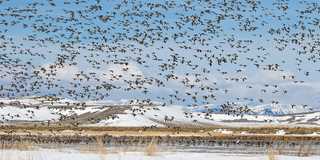
Photo Scott Fink
Most waterfowl hunters understand the effect weather has on waterfowl migration. After all, who among us is not guilty of checking our favorite weather app daily to see if Old Man Winter has awakened and hastened waterfowl migrations? Except for the few species that are hardwired for more dependable long-distance migrations, such as blue-winged teal, waterfowl are adapted to migrate only as far as is necessary for them to find food, open water, and places to rest. For some species, it may take several consecutive days of freezing temperatures and snow cover to push them southward.
Without freezing temperatures and snow to cover food sources, waterfowl linger. It is advantageous for them to reduce risk of mortality from migration and remain closer to spring breeding areas. Especially among mallards and northern pintails, birds that arrive earliest on breeding areas in spring have access to the best territories, which results in a higher probability of nesting successfully and rearing a brood.
Snow and ice cover and their influence on waterfowl migration and distribution are intuitive to most duck hunters. However, what may be less understood is the trend toward warmer winters. The science is very clearif current climate trends continue in North America, midlatitude and northern regions will have less frequent ice and snow cover in future winters. Considering that waterfowl are adapted to stay as close as they can to breeding areas, such a trend does not bode well for waterfowlers farther south. In fact, recent research publications that model both climate and bird distribution indicate that by 2050 the core of the mallard wintering range may extend from Nebraska eastward to the Great Lakes region.
Other species of ducks are likely to be similarly influenced, meaning significantly delayed fall migrations and shorter periods spent on southern wintering areas. Similar northward shifts are being documented in Europe. Given these trends, hunters should expect increased variability in migration activity and waterfowl distribution in the years ahead.
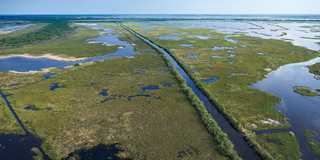
Photo CAMERONDAVIDSON.COM
In the past 200 years the landscapes that are most important to waterfowl have suffered tremendous habitat loss, with some states losing more than 90 percent of wetlands, and nearly all losing over 50 percent. Such rapid change must have had significant effects on waterfowl distribution, but most of the changes occurred before the advent of modern waterfowl management and population surveys.
Perhaps the most discouraging loss of wetlands important to wintering waterfowl has been in coastal Louisiana, where more than 40 percent of the state's approximately 3 million acres of marsh has disappeared over the past several decades. Large portions of remaining coastal wetlands have been invaded by nonnative plants, including water hyacinth and giant Salvinia, which do not provide food resources for waterfowl and outcompete the native plants that do. Such habitat loss and degradation has undoubtedly reduced the number of waterfowl in coastal Louisiana and changed the distribution of birds that still winter there. The decline in resident mottled ducks along the coasts of Louisiana and Texas likely reflects the loss of these crucial marshes.
Across the continent, millions of acres of wildlife habitat have been converted to agriculture. Some waterfowlsuch as geese, mallards, pintails, American green-winged teal, American wigeon, and wood duckshave learned to exploit harvested rice, corn, wheat, barley, peas, and lentils. These landscape changes happened relatively rapidly, and while no one is certain when waterfowl adapted to feed in harvested grainfields, it likely began in the early 20th century, before modern waterfowl science could document the effects of this dramatic landscape change.
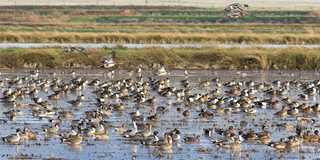
Photo Michael Peters
There is annual and long-term variation in agricultural crops and acreage, both of which influence waterfowl distribution. Along the Louisiana and Texas coasts the amount of rice agriculture, an important resource for wintering waterfowl, has declined from about 1.2 million acres to approximately 500,000 acres since 1970. The decline has been most significant along the Texas Mid-Coast, an area that once supported millions of snow geese and a thriving hunting industry. In recent years, only a couple of hundred thousand snow geese have wintered in coastal Texas. Millions of snows have shifted north to the Mississippi Alluvial Valley, where they find nearly 1 million acres of rice fields and an abundance of other cropland with green winter grasses. The steep decline of rice in Texas and Louisiana has likely also affected the number of puddle ducks wintering in the region, especially seed eaters such as pintails, teal, and mallards.
Farther north, there have been significant increases in the amount of corn agriculture, particularly in North and South Dakota, Iowa, Nebraska, and Minnesota. Not historically a common crop in North Dakota, today corn is grown as far north as Manitoba thanks to the development of varieties that can mature faster in shorter, cooler growing seasons. In recent years, there have been up to 55 million acres of corn planted in the Mississippi River Basin. With millions of acres of harvested wheat, barley, and sorghum also on the landscape, an abundance of waste grain is available to migrating waterfowl, especially if it is not covered by snow.
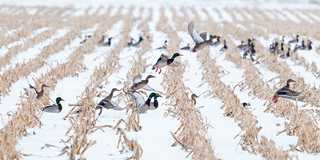
Photo DAVIDSTIMAC.COM
Changes in the amounts and types of crops and the trend toward warmer winters are likely enabling waterfowl to winter farther north or, at the least, delaying fall migration. Annual rainfall also influences waterfowl distribution. For example, the winter of 201819 was the third warmest on record across most of the United States, and in the eastern part of the continent it was the wettest in the more than 120 years that records have been kept by the NOAA National Centers for Environmental Information. With that much water on the landscape, waterfowl had no shortage of places where people were not shooting at thema recipe for a tough duck season. Unsurprisingly, across most of the eastern United States, many waterfowl hunters saw reduced harvest as a result.
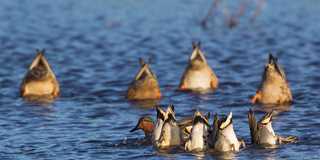
Photo Ken Archer
In the past 50 years, significant wetland restoration has occurred, though the number of restored acres pales in comparison to what has been lost. We lack good information about the ways such restoration has affected waterfowl populations, migrations, or nonbreeding distribution. However, we do know that birds abandon even food-rich habitats when they are covered in ice and snow. Alternatively, in the absence of ice and snow, birds linger at more northerly latitudes due to the adaptations discussed earlier. On most of the important winter and migration landscapes in North America, conservation planning models indicate that the amount of habitat and food energy available during fall and winter is below the levels needed to support established waterfowl population objectives. While conservation efforts continue in these areas, the highly mobile nature of waterfowl enables them to locate and exploit resources where they may exist across larger geographies in a given year.

Photo DOUGSTEINKE.COM
While hunting pressure is probably the least understood variable in the waterfowl distribution equation, we do know that ducks and geese do not like disturbance and will abandon heavily disturbed areas for places where they can find food and rest. Furthermore, hunting has changed in the past few decades. Advances in equipment and technology have made it easier to access nearly all places waterfowl are found. Many hunters have purchased or lease land that is intensively managed to attract waterfowl for hunting, leading to more and often higher-quality habitat on many landscapes. Hunters commonly use motion decoys and machines that keep wetlands from freezing in cold weather. Regulations enabling multiple, split seasons in any given state mean that waterfowl are subjected to more hunting pressure in midlatitude and southern states.
The effects and interactions of these variables are poorly understood. However, the surest way to lower the quality of hunting in your favorite duck hole is to disturb birds too oftenby hunting or even riding through it too frequently. Ducks simply will not tolerate intense disturbance and will readily relocate to other areas, sometimes far away.
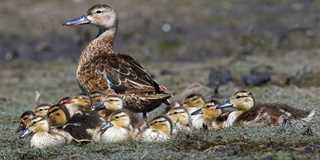
Photo GARYKRAMER.NET
Each year hunters await the release of the Waterfowl Breeding Population and Habitat Survey issued by the US Fish and Wildlife Service. If populations are above average and wetland conditions favorable, breeding waterfowl are generally more successful and production of young increases. Years with more juvenile birds in the fall flight lead to better hunting success and larger harvests across the continent. However, hunters should know that increases in waterfowl breeding populations don't always mean increased production; the surveys are conducted in May, while breeding success depends on habitat conditions well into July.
To achieve greater satisfaction from your hunting season, my best advice is to temper your expectations based on waterfowl breeding populations, and then temper your expectations further based on fall and winter weather to the north of your blind. I hunt in Mississippi, but the weather stations I watch to get a sense of the migration are in Saskatchewan, South Dakota, Nebraska, and Missouri. Only when I see extended freezing temperatures for a week or more in those areas do I know large numbers of birds will be winging their way to the southern end of the flyway.
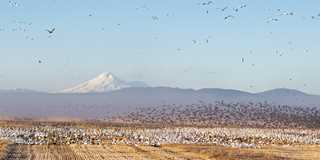
Photo Scott Fink
Then consider habitat conditions across the region you hunt. Birds evaluate habitat conditions on larger scales than your local honey hole. If conditions are good at a landscape scale, birds will stay in the area, and the chances of seeing them over your decoys increase. If the region is excessively flooded, the birds will have many options regarding where they can feed and rest, and you may experience tough hunting. If the region is dry, but there is water in the area you hunt, you may do pretty well.
As hunters we often look for a silver bullet if birds don't show up in anticipated numbers over our decoys. It's human nature to seek simple explanations and solutions, but waterfowl distribution is driven by multiple interacting variables over which humans have little control, some of which are poorly understood. Waterfowl are very well adapted to exploit highly variable environments, and that is part of what makes them such worthy quarry. For those of us who love to pursue ducks and geese, the best way forward is to provide quality habitat, minimize disturbance as much as possible, hope for some help from Old Man Winter, and then hunt as much as our schedules allow!
Ducks Unlimited uses cookies to enhance your browsing experience, optimize site functionality, analyze traffic, and deliver personalized advertising through third parties. By continuing to use this site, you agree to our use of cookies. View Privacy Policy